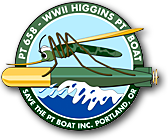|
News Article . . . |
|
From The Oregonian - Tuesday, August 09, 2005 - TED MAHAR
|
|
PT boats: Weapons of war Daring and dashing, PT boats play a pivotal role in Pacific warfare If destroyers were the greyhounds of the sea, PT boats must have been the terriers -- the mutt terriers. Patrol torpedo boats performed invaluable service and fought at closer ranges than any other combat craft. Some collided with Japanese armed barges in furious night skirmishes. In the Pacific island-hopping campaign, U.S. forces often bypassed Japanese island bases, and it was often the PT boats' chore to keep the bypassed islands from being supplied or evacuated. The dashing little craft were conceived for one purpose but more often served another. Their popular image, idealized in John Ford's 1945 film "They Were Expendable," was a bold craft with bolder crews dashing headlong at enemy warships, firing torpedoes and dashing out amid geysers of enemy fire. In fact, some PT boats did attack big ships. More often they slipped out at night, parked on the anticipated course of Japanese ships or barge convoys, and waited. Some crews even removed two or all four of their torpedo tubes to pile on weapons used at more intimate ranges: light and heavy machine guns, and 40 mm cannons. When their radar picked up targets, they roared in firing, wreaking as much havoc as possible, and roared out. Their great speed -- 45 mph or so, if the engines were running perfectly -- often served them better in withdrawal than attack. A tactical advantage PT boats succeeded because Japanese coastal vessels lacked radar, which would have neutralized the PT advantages of stealth and speed. Albert McCready, a retired managing editor of The Oregonian who died in July 2003, was a PT quartermaster. He was among the Save the PT Boat Inc. group that restored Portland's PT 658. "When I was on them, I hated them," McCready said during the restoration. "Thought I was going to get killed. But in retrospect, when we were doing 40 knots on a calm sea and throwing a rooster tail, that was something to see." But mostly, he described his experience as harrowing and hungry. “We were at the absolute tail end of every supply line,” he said. He recalled that they resorted to screwball comedy chicanery to supplement their supplies by conning or even stealing materiel from the Army, Marine or Navy supply ships or shore installations. The Pacific war covered great swaths of areas as the Allies steadily closed in on Japan. Bases continually were established farther up the line. In late 1945 bases for PT boats were scheduled for Okinawa for the vessels to fight in the planned invasion of Japan. The bases were cancelled after the two atomic bombs were dropped on Hiroshima and Nagasaki, and Japan agreed to surrender on Aug. 14. A small, fast force It’s surprising in one way that only two films have been made about PT boats, “Expendable” and 1964’s “PT-109.” PT boat logs could supply spectacle, adventure, action and drama aplenty for the movies. The 60,000 to 64,000 crewmen were all volunteers for close-in fighting in fragile craft in environments made hostile by the enemy and nature. PT boat combat casualties were 331. But by 1947, the U.S. Navy had no more PT boats. More than 100 were burned off a beach at Samar, Philippines. Some were scrapped, some were sold through brokers, and many were given to allies, including China, South Korea and the Soviet Union. The boats in “PT-109” were a smaller craft called crash boats, also called crash/rescue boats, modified to look like PT boats. Crash boats were also used in 1965’s “In Harms Way” and the TV comedy series “McHales Navy.” McReady, astonishingly said that “McHales Navy” was a truer picture of PT boat base life than most people would imagine. Beach life was about as raucous as we could make it,” McReady said. “We drank everything we could get our hands on, which wasn’t very much. We raised all the hell we could to forget about what we did last night and distract us from what we were going to do tonight.” Ted Mahar, Oregonian Staff Writer: 503-221-8228 tedmahar@news.oregonian.com Information Panel on RH side of Illustration UP AGAINST GOLIATHS Pound for pound, PT boats were among the most heavily armed boats of WWII. They could sink ships many times their size using torpedoes, but PT boats found their niche attacking enemy supply and troop barges, in covert operations or rescuing downed pilots. They were regularly sent on missions deemed too risky for larger ships.
PT BOAT BUILDERS
Electric Boat Company (Elco)
|

